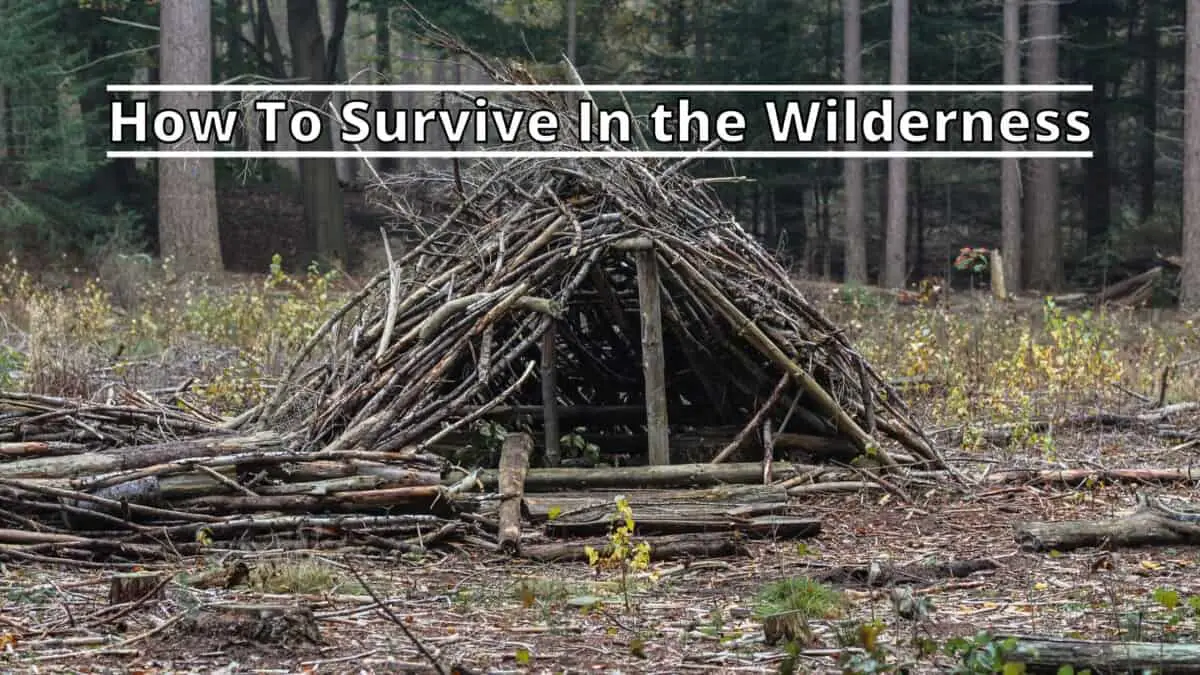Conquering the wilderness can become terrifying, stressful, and exhausting. Always remember, should you run into some kind of problem, it’s not the right time to lose your mental composure. So, set anxiety aside, and stay calm and positive.
No matter how scared you are, you have to develop a plan on how to handle the situation, starting with how to use your skills and resources to look for effective ways to keep yourself safe.
In order to survive in the wilderness, it’s important to stay calm. Don’t panic. Treat injuries if you have any. Keep your mental attitude positive, so you can think straight and use your senses to recover from your situation. Develop a plan, along with your survival interventions to work on —finding shelter, food, water, and fire.
Things can always turn bad whenever you go on an adventure. So, when you’re in survival mode, take a deep breath and assess your situation. Think about your survival techniques. This article will prepare and assist you on how to survive in the wild.
Choosing the right footwear for your hike is very important. Wearing the wrong footwear could lead to sore feet and blisters which will prevent you from enjoying your hike to the fullest. Lucky for you, we have a list of the best hiking shoes for men, women, and children all in one article.
Tips to survive in the wilderness
Whenever you’re in survival mode or not, your safety is always your top priority. You’ll be thinking about how you will set things right and get through it. And to prepare you for that, here are some tips to help you out.
-
Assess your situation
Panicking is not the right thing to do when you’re in survival mode. You’ll not be able to think straight if you focus on the idea of being trapped. All you have to do is stay calm and assess your situation. First, check the resources you have. Then, make a plan, along with the tasks to work on — finding water, shelter, making a fire, etc.
-
Come up with a plan
Make plans as detailed as you can. You better be always prepared and dynamic. If your ‘Plan A’ fails, you can use another method. Therefore, always back up your plan A with a ‘Plan B,’ ‘Plan C,’ ‘Plan D,’ and so on.
-
Build or look for a place to stay
Knowing how to build a shelter is essential for your survival. You have to shield yourself from a potential storm, wind, cold, sun, and wild animals. Your shelter will also provide you a place to rest, recover, and maintain your aim to survive. You can find caves, large and firm trees, or even build your own using the materials you can collect around you.
-
Identify a clean water source
Water plays an essential role in your survival. You can survive without food for eight to twenty-one days, however, you can’t survive without water for more than three days. Therefore, build your shelter as close to a water source as possible. You can look out from streams, rivers, ponds, or creeks, or even collect rain, but make sure to purify the water you collect, since water found in the wild can be contaminated with harmful chemical elements.
-
Learn what you can and cannot eat
Many wild plants are poisonous. Therefore, don’t eat plants you can’t identify. There’s a lot of food we can get out there. Look for anything that swims, crawls, flies, or walks that you could identify safely, and that is easy to prepare.
-
Make a fire
Fire can play a big role in your survival. It can serve as a means to purify water, cook food, signal rescuers, and it can provide light and heat. Collect and use firewood, dry leaves, bark, or grass to start a fire if you don’t have dry tinder.
-
Build a signal
Survival is your top priority, but you need to get rescued as well. To do so, build a communication signal that will help catch the attention of nearby people or a plane that flies overhead. You can use fire, or lay-out stones in the pattern of ‘S.O.S’ or ‘HELP’ as your signal.
-
Stay calm
In a survival situation, positivity and calmness must reign. Think straight. Stay focused, and look at your situation on the bright side. Your survival will depend on how you’ll respond to the situation. So, stay calm and positive.
The first thing you should do to survive if you get lost or stranded in the wild is think about where to find a source of drinkable water nearby. Read our article to learn about the different ways to find water in the wilderness.
Survival items to bring
As previously stated, in a survival situation, positivity and calmness must reign. So, use your senses to help you out, and use the following items.
-
Water and water purification tablets
Water is a basic essential to your survival. Your body will stop functioning after a few days without it. Thus, make sure to bring sufficient water for yourself, and water purification tablets as a back-up in case your supply runs out to avoid contamination. Whenever it’s possible, build your shelter near a water source.
-
Food
When it comes to food, make sure not to bring perishable provisions, nor something that will require electricity. If possible, pack light, and bring food that is easy to eat, like energy bars, dried fruit, nuts, or anything that can be cooked on an outdoor grill.
-
Fire starter
Include a fire starter in your pack as well. Aside from keeping you warm, it could be used as your means for signaling your presence. You can also bring a lighter, matches, or a dry tinder, so that you can use the other one if one of the methods fails.
-
Compass or a map
Packing a map and a compass in your survival kit can help you find your way back to the trailhead in case you get lost. However, it’s important to know that you can’t depend on your mobile phone when it happens.
-
Emergency aid kit
Keep emergency aid kits on hand at all times. Make sure all medical supplies are placed in an accessible part of your bag. In your pack, include gauze, bandages, burn cream, antibiotic ointments, pain medications, and other first-aid tools. These will help you treat minor injuries.
-
Headlamp/flashlight
Emergency kits are more than just medical kits. In surviving situations, light should also be one of the top priorities. It’ll make your situation easier at night, and mostly, when storms, lighting, and other disasters strike. Bringing extra batteries is also a plus since power can run out for days or beyond.
-
Personal hygiene
During an emergency, keeping your body clean with proper sanitation is also important. With that, having supplies to take care of your body is a must. Include the following items in your pack: a towel, antibacterial soap, toothbrush and toothpaste, and other hygiene essentials to help prevent diseases.
- Other survival gear
Pack light, and only bring what you really need, but never forget the essentials. For instance, think about bringing a lighter, knife, raincoat, whistle, sleeping pad, extra batteries, and other emergency tools that will support you in case of an emergency.
Whether you’re a beginner or a seasoned hiker, it’s vital to acquire some skills in order to survive in the backcountry. There are many skills you could learn and we’ll be talking about the 6 survival skills you’ll need in the wilderness.
What should you not do in the wilderness?
As you know, spending time in the wilderness is quite challenging, exhausting, and risky. One wrong move could put you in danger. That’s why the way you respond to the situation you’re getting into is critical.
To reduce risks, here are some things you should remember NOT to do:
-
Not being careful of what you eat
Not being careful of what you eat while surviving in the wilderness might put you in danger. The wilderness is indeed full of edible, wild plants and creatures. But, don’t eat anything you can’t identify. For instance, don’t feed yourself mushrooms, wild berries, bats, lionfish, and other poisonous and dangerous creatures.
-
Not having a safe shelter
Your shelter should protect you; not harm you. With that in mind, don’t build shelters below rocky hillsides, under dead trees, and on flat land for those who are prone to unexpected dangers, as the trees could fall and crush you. The hillsides are also prone to rockslides, and flat areas could lead to flooding.
-
Having a bad state of mind and not paying attention to your surroundings
When you’re stranded in the wild, fear will consume you. It will cause you anxiety and stress. But, don’t let your emotions and fear consume you. This is not the right time to crumble. Take your situation seriously, as one little mistake can lead to terrifying circumstances and accidents.
-
Wasting your energy shouting for help
Whenever you think you’re out of bounds and lost, don’t waste your energy shouting for help. Instead, save that energy to put up your distress signals, and focus on your essentials, like water, food, and fire.
-
Leaving traces
Clean up after yourself! Always be responsible wherever you go. Despite the fact that you’re in the wild and all alone, bear in mind not to leave any traces of yourself. You never know, some of what you leave behind can harm other wild plants and animals.
Sometimes, encountering problems while you’re out hiking cannot be avoided. They can be as simple as painful blisters or as serious as dehydration and fatigue. Read our article to learn about the most common hiking problems and how to avoid them.
Conclusion
The most significant factor to consider for your survival is your attitude. Bear in mind not to let your emotions take over during emergencies. Dwelling on the idea of being stranded will lessen your chances of surviving.
Therefore, always know and understand everything before going on an adventure. You better be always prepared for all possible contingencies you might face along the way. Check out and understand everything we’ve discussed in this article to prepare and assist you in case you get trapped in the wilderness.

